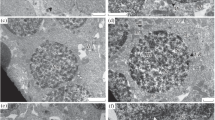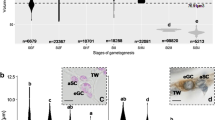Abstract
Testicular germ cells of channel catfish, Ictalurus punctatus, and blue catfish, I. furcatus were separated into four layers with Percoll density gradient centrifugation, containing different cell types (40 % in the first layer were spermatogonial stem cells, SSCs). Expression of seventeen genes was analyzed for cells from different layers by real-time quantitative PCR. Pfkfb4, Urod, Plzf, Integrin6, IntegrinV, Thy1 and Cdh1 genes showed the same expression change pattern in both channel and blue catfish as these genes were down-regulated in the spermatocytes and even more so in spermatids. Plzf and Integrin6 had especially high expression in SSCs and can be used as SSCs specific markers. Sox2 gene was up-regulated in spermatocytes and even more highly up-regulated in spermatids, which indicated it could be a spermatid marker. In contrast to channel catfish, Id4, Smad5 and Prdm14 gene expressions were strongly down-regulated in spermatocyte cells, but up-regulated in spermatid cells in blue catfish. Smad5 gene was down-regulated in spermatocytes, but up-regulated in both spermatogonia and spermatids, allowing identification as a marker for spermatocytes in blue catfish. Oct4, Id4, Gfrα2, Pum2 and Prdm14 genes showed different expression patterns in the testicular germ cells of channel and blue catfish. This may be a partial explanation to the differing responses of channel catfish and blue catfish to induced spawning technologies. The SSCs specific markers can be used for further SSCs labeling, which can increase the SSCs sorting efficiency and be applied in various studies involving SSCs and other germ cells.





Similar content being viewed by others
Abbreviations
- SSCs:
-
Spermatogonial stem cells
- PGCs:
-
Primordial germ cells
- TL:
-
Total length
- qPCR:
-
Real-time quantitative PCR
References
Avilion AA, Nicolis SK, Pevny LH, Vivian N, Lovell-Badge R (2003) Multipotent cell lineages in early mouse development depend on SOX2 function. Genes Dev 17:126–140
Buaas FW, Kirsh AL, Sharma M, McLean DJ, Morris JL, Griswold MD, de Rooij DG, Braun RE (2004) Plzf is required in adult male germ cells for stem cell self-renewal. Nat Genet 36:647–652
Chang H, Matzuk MM (2001) Smad5 is required for mouse primordial germ cell development. Mech Dev 104:61–67
Costoya JA, Hobbs RM, Barna M, Cattoretti G, Manova K, Sukhwani M, Orwig KE, Wolgemuth DJ, Pandolfi PP (2004) Essential role of Plzf in maintenance of spermatogonial stem cells. Nat Genet 36:653–659
Dunham RA, Argue BJ (2000) Reproduction among channel catfish, blue catfish, and their F1 and F2 hybrids. Trans Am Fish Soc 129:222–231
Dunham RA, Masser M (2012) Production of hybrid catfish. SRAC No. 190, Southeastern Regional Aquaculture Center, Stoneville, Mississippi, USA
Fumarola D, Antonaci S, Jirillo E, Munno I, Lucivero G, Bonomo L (1982) Percoll density gradient centrifugation. Res Clin Lab 12:485–491
Hofmann MC, Braydich-Stolle L, Dym M (2005) Isolation of male germ-line stem cells; influence of GDNF. Dev Biol 279:114–124
Kokkinaki M, Djourabtchi A, Nady Golestaneh N (2011) Long-term culture of human SSEA-4 positive spermatogonial stem cells (SSCs). J Stem Cell Res Ther 2:2488
Kubota H, Avarbock MR, Brinster RL (2003) Spermatogonial stem cells share some, but not all, phenotypic and functional characteristics with other stem cells. Proc Natl Acad Sci U S A 100:6487–6492
Lacerda SMSN, Batlouni SR, Silva SBG, Homem CSP, França LR (2006) Germ cells transplantation in fish: the Nile-tilapia model. Anim Reprod 3:146–159
Lacerda SMSN, Batlouni SR, Costa GM, Segatelli TM, Quirino BR, Queiroz BM, Kalapothakis E, França LR (2010) A new and fast technique to generate offspring after germ cells transplantation in adult fish: the Nile Tilapia (Oreochromis niloticus) model. PLoS One 5:e10740
Lacerda SMSN, Aponte PM, Costa GMJ, Campos-Junior PHA, Segatelli TM, Silva MA, França LR (2012) An overview on spermatogonial stem cell physiology, niche and transplantation. Anim Reprod 9:798–808
Leal MC, Cardoso ER, Nobrega RH, Batlouni SR, Bogerd J, Franca LR, Schulz RW (2009) Histological and stereological evaluation of zebrafish (Danio rerio) spermatogenesis with an emphasis on spermatogonial generations. Biol Reprod 81:177–187
Leong KG, Wang BE, Johnson L, Gao WQ (2008) Generation of a prostate from a single adult stem cell. Nature 45:804–808
Li C, Beck HB, Peatman E (2014) Nutritional impacts on gene expression in the surface mucosa of blue catfish (Ictalurus furcatus). Dev Comp Immunol 44:226–234
Livak KJ, Schmittgen TD (2001) Analysis of relative gene expression data using real-time quantitative PCR and the \(2^{{ - \Delta \Delta C_{\text{t}} }}\) method. Methods 25:402–408
Meng X, Lindahl M, Hyvönen ME, Parvinen M, de Rooij DG, Hess MW, Raatikainen-Ahokas A, Sainio K, Rauvala H, Lakso M, Pichel JG, Westphal H, Saarma M, Sariola H (2000) Regulation of cell fate decision of undifferentiated spermatogonia by GDNF. Science 287:1489–1493
Moore FL, Jaruzelska J, Fox MS, Urano J, Firpo MT, Turek PJ, Dorfman DM, Pera RA (2003) Human Pumilio-2 is expressed in embryonic stem cells and germ cells and interacts with DAZ (Deleted in AZoospermia) and DAZ-like proteins. Proc Natl Acad Sci U S A 100:538–543
Morita T, Kumakura N, Morishima K, Mitsuboshi T, Ishida M, Hara T, Kudo S, Miwa M, Ihara S, Higuchi K, Takeuchi Y, Yoshizaki G (2012) Production of donor-derived offspring by allogeneic transplantation of spermatogonia in the yellowtail (Seriola quinqueradiata). Biol Reprod 86:176
Nagasawa K, Shikina S, Takeuchi Y, Yoshizaki G (2010) Lymphocyte antigen 75 (Ly75/CD205) is a surface marker on mitotic germ cells in rainbow trout. Biol Reprod 83:597–606
Nakamura Y, Muguruma Y, Yahata T, Miyatake H, Sakai D, Mochida J, Hotta T, Ando K (2006) Expression of CD90 on keratinocyte stem/progenitor cells. Br J Dermatol 154:1062–1070
Nobrega RH, Greebe CD, van de Kant H, Bogerd J, França LR, Schulz RW (2010) Spermatogonial stem cell niche and spermatogonial stem cell transplantation in zebrafish. PLoS One 5:e12808
Oatley MJ, Kaucher AV, Racicot KE, Oatley JM (2011) Inhibitor of DNA binding 4 is expressed selectively by single spermatogonia in the male germline and regulates the self-renewal of spermatogonial stem cells in mice. Biol Reprod 85:347–356
Ohmura M, Yoshida S, Ide Y, Nagamatsu G, Suda T, Ohbo K (2004) Spatial analysis of germline stem cell development in Oct-4/EGFP transgenic mice. Arch Histol Cytol 67:285–296
Okutsu T, Suzuki K, Takeuchi Y, Takeuchi T, Yoshizaki G (2006) Testicular germ cells can colonize sexually undifferentiated embryonic gonad and produce functional eggs in fish. Proc Natl Acad Sci U S A 103:2725–2729
Ozaki Y, Saito K, Shinya M, Kawasaki T, Sakai N (2011) Evaluation of Sycp3, Plzf and Cyclin B3 expression and suitability as spermatogonia and spermatocyte markers in zebrafish. Gene Expr Patterns 11:309–315
Panda RP, Barman HK, Mohapatra C (2011) Isolation of enriched carp spermatogonial stem cells from Labeo rohita testis for in vitro propagation. Theriogenology 76:241–251
Perera DA (2012) Studies for improvement of reproductive biotechnology for production of channel catfish (Ictalurus punctatus) female X blue catfish (Ictalurus furcatus) male hybrid embryos. Doctoral dissertation, Auburn University, AL, USA
Rozen S, Skaletsky HJ (2000) Primer3 on the WWW for general users and for biologist programmers. In: Krawetz S, Misener S (eds) Bioinformatics methods and protocols: methods in molecular biology. Humana Press, Totowa, pp 365–386
Sánchez-Sánchez AV, Camp E, García-España A, Leal-Tassias A, Mullor JL (2010) Medaka Oct4 is expressed during early embryo development, and in primordial germ cells and adult gonads. Dev Dynam 239:672–679
Shang M (2013) Isolation, identification, culture, cryopreservation, genetic transformation and transplantation of catfish germline stem cells. Doctoral dissertation, Auburn University, AL, USA
Shinohara T, Avarbock MR, Brinster RL (1999) β1- and α6-integrin are surface markers on mouse spermatogonial stem cells. Proc Natl Acad Sci U S A 96:5504–5509
Shinohara T, Orwig KE, Avarbock MR, Brinster RL (2000) Spermatogonial stem cell enrichment by multiparameter selection of mouse testis cells. Proc Natl Acad Sci U S A 97:8346–8351
Sun F, Liu S, Gao X, Jiang Y, Perera D, Wang X, Li C, Sun L, Zhang J, Kaltenboeck L, Dunham R, Liu Z (2013) Male-biased genes in catfish as revealed by RNA-Seq analysis of the testis transcriptome. PLoS One 8:e68452
Tokuda M, Kadokawa Y, Kurahashi H, Marunouchi T (2007) CDH1 is a specific marker for undifferentiated spermatogonia in mouse testes. Biol Reprod 76:130–141
Vilela DAR, Silva SGB, Peixoto MTD, Godinho HP, Franca LR (2003) Spermatogenesis in teleost: insights from the Nile tilapia (Oreochromis niloticus) model. Fish Physiol Biochem 28:187–190
Yamaji M, Seki Y, Kurimoto K, Yabuta Y, Yuasa M, Shigeta M, Yamanaka K, Ohinata Y, Saitou M (2008) Critical function of Prdm14 for the establishment of the germ cell lineage in mice. Nat Genet 40:1016–1022
Yano A, von Schalburg K, Cooper G, Koop BF, Yoshizaki G (2009) Identification of a molecular marker for type A spermatogonia by microarray analysis using gonadal cells from pvasa-GFP transgenic rainbow trout (Oncorhynchus mykiss). Mol Reprod Dev 76:246–254
Yoshida S, Takakura A, Ohbo K, Abe K, Wakabayashi J, Yamamoto M, Suda T, Nabeshima Y (2004) Neurogenin3 delineates the earliest stages of spermatogenesis in the mouse testis. Dev Biol 269:447–458
Yoshikawa H, Morishima K, Fujimoto T, Saito T, Kobayashi T, Yamaha E, Arai K (2009) Chromosome doubling in early spermatogonia produces diploid spermatozoa in a natural clonal fish. Biol Reprod 80:973–979
Yoshizaki G, Tago Y, Takeuchi Y, Sawatari E, Kobayashi T, Takeuchi T (2005) Green fluorescent protein labeling of primordial germ cells using a nontransgenic method and its application for germ cell transplantation in salmonidae. Biol Reprod 73:88–93
Yoshizaki G, Ichikawa M, Hayashi M, Iwasaki Y, Miwa M, Shikina S, Okutsu T (2010) Sexual plasticity of ovarian germ cells in rainbow trout. Development 137:1227–1230
Yuan L, Liu JG, Zhao J, Brundell E, Daneholt B, Höög C (2000) The murine SCP3 gene is required for synaptonemal complex assembly, chromosome synapsis, and male fertility. Mol Cell 5:73–83
Zayas J, Spassov DS, Nachtman RG, Jurecic R (2008) Murine hematopoietic stem cells and multipotent progenitors express truncated intracellular form of c-kit receptor. Stem Cells Dev 17:343–353
Acknowledgments
This work was partially funded by the USDA-Biotechnology Risk Assessment Program (Grant No. 2009-33522-05774), the Alabama Agricultural Experiment Station (80-009) and the Office of the Vice President for Research, Auburn University (OVPR-AU-IGP).
Author information
Authors and Affiliations
Corresponding author
Additional information
Mei Shang and Baofeng Su are co-first authors.
Electronic supplementary material
Below is the link to the electronic supplementary material.
Rights and permissions
About this article
Cite this article
Shang, M., Su, B., Lipke, E.A. et al. Spermatogonial stem cells specific marker identification in channel catfish, Ictalurus punctatus and blue catfish, I. furcatus . Fish Physiol Biochem 41, 1545–1556 (2015). https://doi.org/10.1007/s10695-015-0106-1
Received:
Accepted:
Published:
Issue Date:
DOI: https://doi.org/10.1007/s10695-015-0106-1




